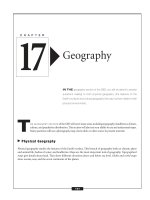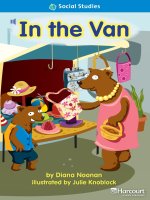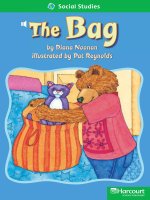4 2 6 storytelling through the years (social studies)
Bạn đang xem bản rút gọn của tài liệu. Xem và tải ngay bản đầy đủ của tài liệu tại đây (5.47 MB, 18 trang )
Storytelling
Through the Years
by Kristin Marciniak
H O UG H T O N MIF F L IN
Storytelling
Through the Years
by Kristin Marciniak
PHOTOGRAPHY CREDITS: Cover © Golden Pixels LLC/Alamy; tp © Spencer Grant/PhotoEdit; 3 © Bob Winsett/Jupiter
Images; 5 © Golden Pixels LLC/Alamy; 6 © Robbie Jack/Corbis; 8 © Spencer Grant/PhotoEdit; 9 © Mary Evans Picture
Library/Edwin Wallace/The Image Works; 10 © Stefano Bianchetti/Corbis; 11 © TH Foto/Alamy; 12 © Hulton Archive/
Handout/Getty Images; 13 © North Wind Picture Archives/Alamy; 14 © Ariel Skelley/Corbis.
Copyright © by Houghton Mifflin Harcourt Publishing Company
All rights reserved. No part of this work may be reproduced or transmitted in any form or by any means, electronic or
mechanical, including photocopying or recording, or by any information storage and retrieval system, without the prior
written permission of the copyright owner unless such copying is expressly permitted by federal copyright law. Requests
for permission to make copies of any part of the work should be addressed to Houghton Mifflin Harcourt School Publishers,
Attn: Permissions, 6277 Sea Harbor Drive, Orlando, Florida 32887-6777.
Printed in China
ISBN-13: 978-0-547-42710-2
ISBN-10: 0-547-42710-7
1 2 3 4 5 6 7 8 0940 18 17 16 15 14 13 12 11
If you have received these materials as examination copies free of charge, Houghton Mifflin Harcourt School Publishers
retains title to the materials and they may not be resold. Resale of examination copies is strictly prohibited.
Possession of this publication in print format does not entitle users to convert this publication, or any portion of it, into
electronic format.
Table of Contents
Oral Traditions
4
Using Song to Tell Stories
5
Puppets in Storytelling
6
Folktales
7
Legends
9
Myths
10
How Technology Changed Storytelling
11
Storytelling Today
14
Suppose you are sitting with your
friends and family around a campfire roasting
marshmallows and telling stories. Your older
brother begins to tell a scary story.
“Once upon a time, there was a hideous
dragon that lived inside a volcano,” he begins.
“The volcano was always exploding, and the
dragon was always roaring. Everyone was afraid
of the dragon.”
Some scary stories are passed from generation
to generation.
3
Your older brother tells the story, but he
heard it from your mother. Your mother first
heard it from her mother, and so on. This is an
example of an oral tradition.
Oral Tradition
Oral tradition, or storytelling, is a way of
passing history and stories from one generation
to another. Before the printing press was
invented, storytelling was one of the only ways
that many societies were able to keep records.
If people didn’t share their stories, an immense
amount of history would be lost.
4
Since stories were not written down,
storytellers had to rely on their memories.
Storytellers would learn the basic plot and
then make up details as they went along. That is
why there are sometimes many versions of the
same story.
Using Songs to Tell Stories
Storytellers sometimes sang their stories.
A ballad, also known as a folk song, is a story
in song. They might tell about a prince who
becomes invisible to rescue a princess.
Some storytellers used ballads to tell
their tales.
5
Puppets in Storytelling
Have you ever been to a puppet show?
The art of using puppets to tell stories has been
around for thousands of years. This art form
began in ancient Greece.
In ancient India, puppets were used to tell
religious and historical stories about kings,
gods, and other events. A story might be about
a warrior who refuses to give up. Puppet shows
continue to delight audiences even today.
Puppets were used to tell stories before actors
performed them.
6
Folktales
Oral stories also were used to teach lessons.
There are many different kinds of stories, but
some common ones are folktales, legends, and
myths. Folktales are fictional stories about
people or animals that speak and act like
people. Fairytales are one type of folktale.
Folktales teach lessons about how people
are supposed to act. Good characters always
win in the end, but they only get there with
determination. For example, in the story of
Cinderella, we learn that being wealthy and
important are not the ways to happiness.
7
Native Americans
used storytelling
to pass down their
cultural history.
Folktales were originally stories for adults.
They were popular entertainment for farmers,
sailors, and other workers. Many of them did
not know how to read. In addition, many Native
Americans and American slaves used oral
traditions to preserve their history. Today, some
tribes in Africa still use oral storytelling as the
main way to keep records of events.
8
Legends
Unlike folktales, legends are stories that
are thought to be true. Legends are always
about a person or subject that many people
believed was real. Most legends are about kings,
heroes, or a battle. Famous legends include the
stories of Robin
Hood, and King
Arthur and the
Knights of the
Round Table.
The legend of the
Sword in the Stone
tells how King
Arthur became the
king of Britain.
9
Myths
Another type of story is a myth. Myths
are sacred stories from the past that explain a
culture’s beliefs and values. Myths are also used
to explain unusual events or how something
came to exist. Most myths come from religion.
The ancient Greeks had many myths that
are still around today. Hercules is one of those
myths. He was very strong and brave.
The story of Hercules is an example of a Greek myth.
10
Writing helped to change the way stories are shared.
How Technology Changed
Storytelling
Technology has shaped the ways stories are
passed from generation to generation. Writing
has been found carved on stones and walls from
thousands of years ago. Paper was later invented
in ancient China, but people still had to write
by hand. During the 14th and 17th centuries,
people were hired to copy texts into books.
This, however, was a very slow process.
11
In the mid-1400s, a German inventor
named Johannes Gutenberg made the first
printing press. Gutenberg’s first version was
made of blocks with raised letters. The letters
were inked much like the rubber stamps you
can buy in craft stores today. This invention
made it much easier to print books.
Johannes Gutenberg was born in
Mainz, Germany, around 1400. He worked
as a stonecutter and goldsmith. These
experiences helped him to create the metal
molds for the letters.
12
The invention of the printing press did
not decrease the importance of oral traditions.
Except for those who were rich, most people did
not know how to read. They also were not able
to get the printed books.
Books became more widely available with
the invention of the monotype machine in
1897. This meant that the books were less
expensive than before, so more people were
able to read them.
The printing press
made it much easier
to print books and
share stories.
13
Storytelling Today
Today, modern technology helps us publish
stories at astonishing rates. Newspapers tell
us what’s going on and we read books for
education and entertainment. The Internet also
allows us to access information quickly.
Despite all of these forms of media, traces of
oral storytelling are all around. Each time you
share a bedtime story, a joke, or a family legend
with others, you are helping to keep the oral
tradition alive.
Most people still like to
listen to a good story.
14
Responding
Word Builder Make
a word web around the word hideous. What
synonyms do you know for the word hideous?
Copy and complete the word web below.
TARGET VOCABULARY
disgusting
nasty
hideous
?
?
Write About It
Text to Text You just read about how
stories have been shared. Write a paragraph
describing a story you have read that may have
started in the oral tradition. Use a word from
the Word Builder in your writing.
15
TARGET VOCABULARY
battle
exploding
hideous
hired
immense
invisible
refused
rescue
warrior
wealthy
Infer/Predict Use text clues to
figure out what isn’t directly stated by the author.
TARGET STRATEGY
Which word rhymes with a word that
describes how you feel when you are ready for bed?
16
Level: Q
DRA: 40
Social Studies
Strategy:
Infer/Predict
Word Count: 930
4.2.6 Build Vocabulary
HOUGHTON MIFFLIN
Online Leveled Books
ISBN-13: 978-0-547-02324-3
ISBN-10: 0-547-02324-3
1032175









